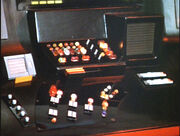Introduction[]
Before you make your own TOS displays, it is important to familiarize yourself with how the TOS displays were put together, so your own versions will be as accurate as possible to the 23rd century. It is important to understand that TOS computer interface systems operated entirely differently than on other "Star Trek" shows. There were three main ways of interfacing with the ship’s duotronic computer systems, which will be explained briefly.
Library Computer Access[]

A Computer Interface Unit
Interface[]
- Duotronic computer interfaces in the TOS era were of a completely auditory nature. Information was accessed by issuing verbal commands to the computer interface unit (usually a box-like unit covered in status lights, pictured at right, or the Science station on the Bridge), which would respond by speaking in return to the user - a high-tech, "hands-free" interface system. Simulations and calculations could be performed through this way. If charts, slides, or records of a visual nature were required, they could be displayed on monitor screens (either small tabletop units or the large overhead screens installed on the Bridge) for briefings or presentations. Audio, photographic, or video records alike could be recorded on color-coded data tapes for later use.
- Visual records themselves ranged from personnel psychological records to books, hull pressure component displays, planet profiles, solar system charts, engineering diagrams, video recordings, and simple photographic records. Visual records did not possess a unified style or appearence.

Using an electronic clipboard to enter information instead of typing or speaking.
Data Input Processes[]
- Data was generally entered into the ship’s computer by speaking, as in during the recording of a log entry or a report. Alternately, written information could also be used to enter information into the computer banks, although this was done by writing on an electronic clipboard (pictured at right) as opposed to typing it on a keyboard.
.
Bridge Stations[]

Science Station, with a Library Computer Tie-In
Interface[]
- Bridge stations aboard 23rd century star cruisers were each specifically designed to serve a particular function and were not interchangeable; each control surface was unique to the function it was intended to perform, as were the display screens. The Communications station possessed different controls and screens than the Engineering station, for example, and one could not use the Science station to perform the duties of the Environmental station.
- Control surfaces consisted of a variety of colored, transluscent touch-sensitive nodules which came in various shapes and sizes, mounted on a black surface. Additional banks of physical push-button, flip, and rocker switches rounded out each control surface, as well as specialized black, rectangular buttons with specific labels on their surface.
- The only Bridge station with a tie-in to the ship’s records and library computer was the Science station; as previously stated this was performed verbally and without the use of displays, unless photographic or video records from the library banks were requested.
Status Read-Out Display Screens[]

A Status Read-Out from the Communications Station
- The read-outs surrounding a certain Bridge station were not library computer access screens. They merely displayed information pertinent to the function of that particular station; for example, the screens at the Communications station showed the status of various systems pertaining to Communications, such as frequency modulations or the function of the Universal Translator.
- Each read-out display screen consisted of a flat black background, with the details of the display overlaid on the surface.
- [More will be added]
Status Display Boards[]

Status Display Board being used by a transporter technician.
Large Status Display Boards were also used to monitor activity of various onboard systems, and functioned in a similar manner to the Status Read-out Screens installed on the Bridge.
These display boards could be seen in various locations onboard star cruisers; a Constitution-variant starship had at least one in Main Engineering, one in Sickbay, and one behind the controls in one of the Transporter rooms. The white lines represented Duotronic circuitry routes and power conduits, and the color-coded sections changed color depending on the status or function of a particular subsystem. The board in Main Engineering had a wider range of functions, and worked in tandum with a control console below it. The board's display would have different meanings depending on which system a user instructed it to display by using the control console. A green light near one of the circuits on the display board might be a good thing if the board was set to show life support status, but it would mean something completely different if the board had been set to monitor warp reactor functions.
Color Standards[]
The three main colors seen on TOS visual interfaces were Red, Gold, and Green on a flat Black background. Orange was also used to a great extent, but not for status display lights and was confined to charts, either of starships or power level indicators. Blue and Purple could also be observed, albeit in very small parts and were not heavily used. [More will be added]
Font Standards[]
The font used on TOS interfaces was Corporate Condensed. If this font is unavailable, Haettenschweiler is a default font that comes with Microsoft Word, and is similar enough for reasonable accuracy (especially where numbers are concerned).
Elements Standards[]
Introduction to elements of the interface. Feel free to add any other elements using "===Name===" format.
Buttons[]
Touch-screen interfaces were not used in the TOS era, so buttons were not integrated into screens and were confined to control boards. [More will be added]